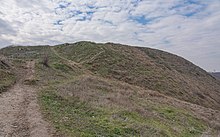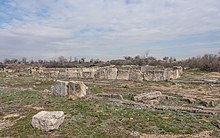Colossai

Kolossai ( ancient Greek Κολοσσαί, Latin form of the name Herakles ) was in ancient times a city in Asia Minor landscape Phrygia . The place is four kilometers north of Honaz ( Chonai ), 20 km east of Denizli .
Kolossai lies in the upper Lykostal region (today's western Turkey); Neighboring cities were Laodikeia on Lykos and Hierapolis . The city was on a trade route that led to Ephesus and Miletus .
The city was already significant in the 5th century BC. The procession of the ten thousand ( Anabasis , 401–399 BC) probably passed the city in 401 (Xenophon). Coins have been proven since the late Hellenistic period. In the imperial period, however, it played no special role and was completely overshadowed by the more important Laodikeia.
Here, as in the neighboring towns, there was a Christian community early on; known mainly from the letter of the apostle Paul to the Christian community in the city ( Colossians ). Philemon, the recipient of the letter of the same name , is said to have been the first bishop of Colossai. At one as early as the 6th century BC As evidenced by the crevices in the earth, a cult of the Archangel Michael developed , and a healing spring was created that was much visited in Byzantine times. Presumably in connection with the Arab wars or due to earthquakes in the 8th century, the settlement was relocated from the Kolossai on the plain to Chonai . Michaelskirche was in the area of Kolossai, after the settlement it belonged to Chonai.
The Archdiocese of Colossae is now a titular archbishopric of the Roman Catholic Church .
literature
- Klaus Belke , Norbert Mersich: Phrygia and Pisidia. Tabula Imperii Byzantini , 7. Vienna 1990. pp. 309-311.
- Celal Şimşek: Colossai. Arkeoloji ve Sanat 107 (2002) pp. 3-16.
Web links
- Angela Standhartinger : Kolossae. In: Michaela Bauks, Klaus Koenen, Stefan Alkier (Eds.): The Scientific Biblical Lexicon on the Internet (WiBiLex), Stuttgart 2006 ff.
- Kolossae, a biblical place, on www.bibleplaces.com
- Coins from Kolossai
- engl. Page with links to pages about Colossae (Internet Links for the Study of Colossians)
Coordinates: 37 ° 47 ′ 11.9 " N , 29 ° 15 ′ 35.8" E
